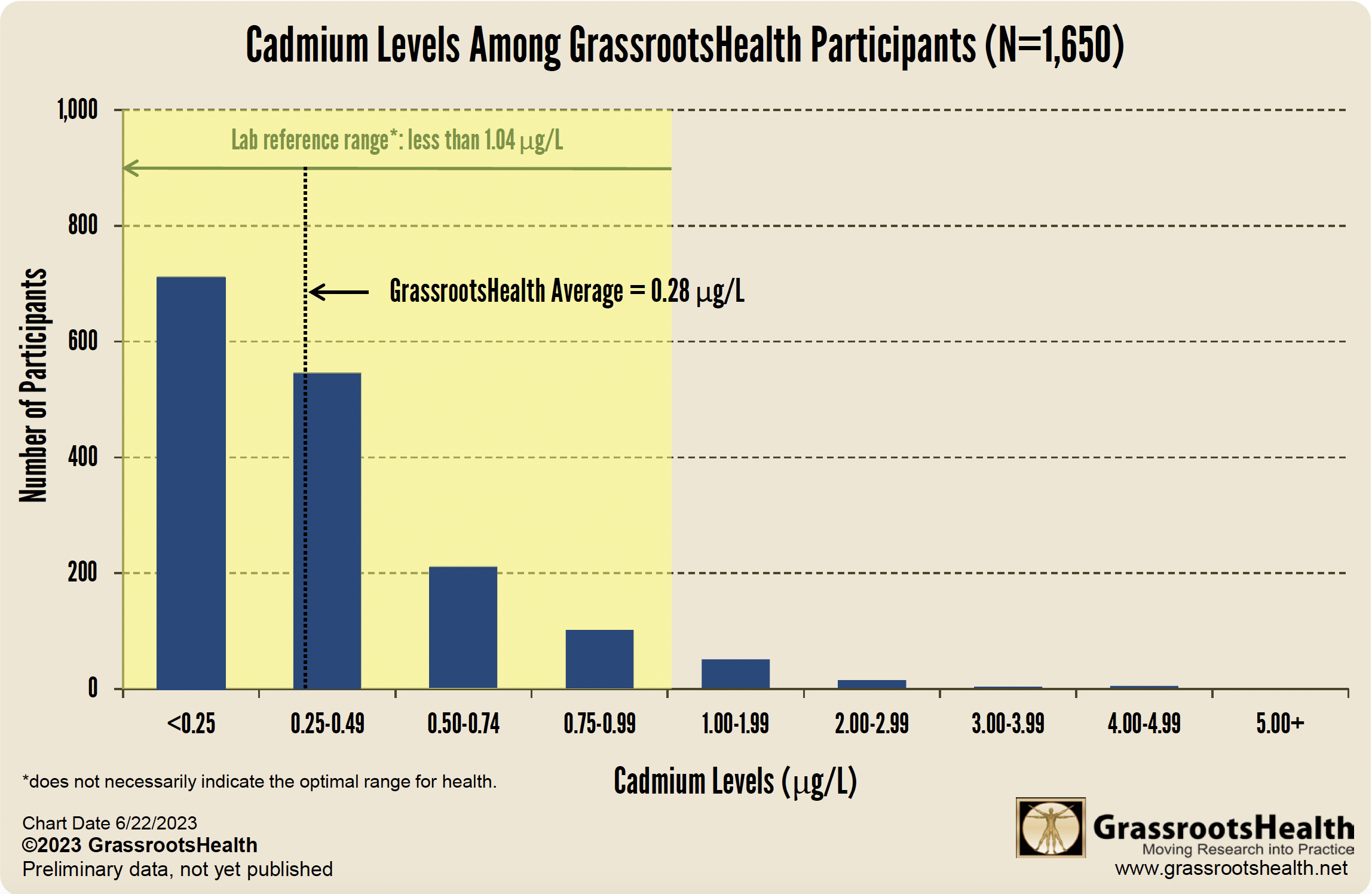Published on December 18, 2023
Cadmium accumulates in the kidneys and thyroid gland, and can contribute to thyroid issues, infertility, uterine fibroids, and other reproductive tract diseases… are you being affected by cadmium toxicity?
Key Points
-
- While the primary source of cadmium for most individuals is from food, smokers tend to have about twice the toxic burden of cadmium than non-smokers; individuals who work in the smelting, battery manufacturing, colored glass manufacturing, and waste incinerating industries tend to have higher exposure to cadmium
- Long-term, lower level exposure results in cadmium accumulation in the kidneys and thyroid gland, and can contribute to thyroid issues, kidney disease, infertility, uterine fibroids, and other reproductive tract diseases if the build-up is high enough; cadmium has also been found to cause cancer and to affect the body’s cardiovascular, neurological, gastrointestinal, and respiratory systems
- Among 1,650 participants who had tested their cadmium levels through GrassrootsHealth, 57% had detectable levels of cadmium with approximately 5% having levels above the reference range cut-off; 276 participants had completed at least two cadmium tests, approximately 65% of whom lowered their cadmium levels after their first test
- Save 15% when including the Full Elements Panel in your test kit with code ELEMENTS15, now through 12/22/23
Add the Elements Panel to Your Home Test Kit Here
 Toxic elements, such as lead, cadmium, and mercury, have no known nutritional benefit and are known to interfere with proper functioning of proteins, lipids, and DNA within the cells. They can also interfere with essential elements by blocking their availability within the body. Toxins can contribute to the development of chronic diseases, making detoxification an important step towards healing and health, as briefly discussed by Dr. Richard Cheng in a recent post here.
Toxic elements, such as lead, cadmium, and mercury, have no known nutritional benefit and are known to interfere with proper functioning of proteins, lipids, and DNA within the cells. They can also interfere with essential elements by blocking their availability within the body. Toxins can contribute to the development of chronic diseases, making detoxification an important step towards healing and health, as briefly discussed by Dr. Richard Cheng in a recent post here.
The Full Elements panel offered by GrassrootsHealth measures the levels of essential elements magnesium, copper, selenium and zinc, as well as toxic elements lead, cadmium and mercury. We recently reviewed an updated analysis of lead results among GrassrootsHealth participants. Below is a summary of the latest analysis of cadmium levels among GrassrootsHealth participants, completed in June of 2023. An updated summary of mercury levels among GrassrootsHealth participants will be covered in our next upcoming post.
How does Cadmium Affect Your Health?
Cadmium, classified as a group 1 carcinogen, can be found in certain industrial environments and in soil. Certain plants and foods, such as tobacco, green leafy vegetables, potatoes and grains, peanuts, soybeans, sunflower seeds, and shellfish can contain high levels of cadmium.
While the primary source of cadmium for most individuals is from food, smokers tend to have about twice the toxic burden of cadmium than non-smokers. Individuals who work in the smelting, battery manufacturing, colored glass manufacturing, and waste incinerating industries tend to have higher exposure to cadmium.
Long-term, lower level exposure results in cadmium accumulation in the kidneys and thyroid gland, and can contribute to thyroid issues, kidney disease, infertility, uterine fibroids, and other reproductive tract diseases if the build-up is high enough. Cadmium has also been found to cause cancer and to affect the body’s cardiovascular, neurological, gastrointestinal, and respiratory systems.
What are Cadmium Levels Among GrassrootsHealth Participants?
Among the 1,650 participants who had tested their cadmium levels, 57% had detectable levels of cadmium with approximately 5% having levels above the reference range cut-off. The average level was 0.28 μg/L, which is lower than our last average of 0.36 μg/L in June of 2020. A vast majority had levels within the lab reference range (less than 1.04 μg/L); this reference range indicates the range of typical results found in the population the lab serves but does not necessarily indicate the optimal range for health.
Additionally, 276 participants had completed at least two cadmium tests. Among these participants, approximately 65% lowered their cadmium levels after their first test.
The dried blood spot test for cadmium is a reflection of short-term cadmium exposure. Learn more about cadmium and lead levels among past and current smokers in the GrassrootsHealth cohort here.
Zinc May Help Protect Against the Negative Effects of Cadmium
Studies have shown that low levels of zinc in the body may increase the risk of diseases resulting from cadmium toxicity, due to the antagonistic relationship between zinc and cadmium. According to Richter et al., “Cadmium antagonizes or inhibits some of the necessary biochemical functions of zinc and supplemented zinc inhibits or reverses some toxicological effects of cadmium. Consequently, the cadmium/zinc ratio may be more informative of health status than the concentrations of either metal alone.”
Make sure you are not being over exposed to the toxic elements mercury, cadmium and lead, and that you are getting enough protective minerals magnesium, selenium, copper and zinc! Measure your levels of each by adding the Elements Panel to your next GrassrootsHealth home test kit.
Add the Elements Panel to Your Home Test Kit Here
(Save 15% with code ELEMENTS15 now through 12/22/23)
Need help eliminating some of these toxic metals? Learn more about Heavy Metals and the Power of Detoxification.
Test Your Cadmium Level as Part of the Elements Panel
 Measuring your level of lead and other toxic elements can help determine if you and your loved ones are being exposed, and if steps need to be taken to decrease that exposure and build-up in the body. Decreasing toxic elements while having and maintaining healthy levels of essential elements, vitamin D, and other nutrients can help improve your health now and for your future. Choose which to measure, such as your vitamin D, omega-3s, and essential and toxic minerals including magnesium and iron, by creating your custom home test kit today. Take steps to improve the status of each of these measurements to benefit your overall health. You can also track your own intakes, symptoms and results to see what works best for YOU.
Measuring your level of lead and other toxic elements can help determine if you and your loved ones are being exposed, and if steps need to be taken to decrease that exposure and build-up in the body. Decreasing toxic elements while having and maintaining healthy levels of essential elements, vitamin D, and other nutrients can help improve your health now and for your future. Choose which to measure, such as your vitamin D, omega-3s, and essential and toxic minerals including magnesium and iron, by creating your custom home test kit today. Take steps to improve the status of each of these measurements to benefit your overall health. You can also track your own intakes, symptoms and results to see what works best for YOU.
Enroll and test your levels today, learn what steps to take to improve your status of vitamin D (see below) and other nutrients and blood markers, and take action! By enrolling in the GrassrootsHealth projects, you are not only contributing valuable information to everyone, you are also gaining knowledge about how you could improve your own health through measuring and tracking your nutrient status, and educating yourself on how to improve it.






